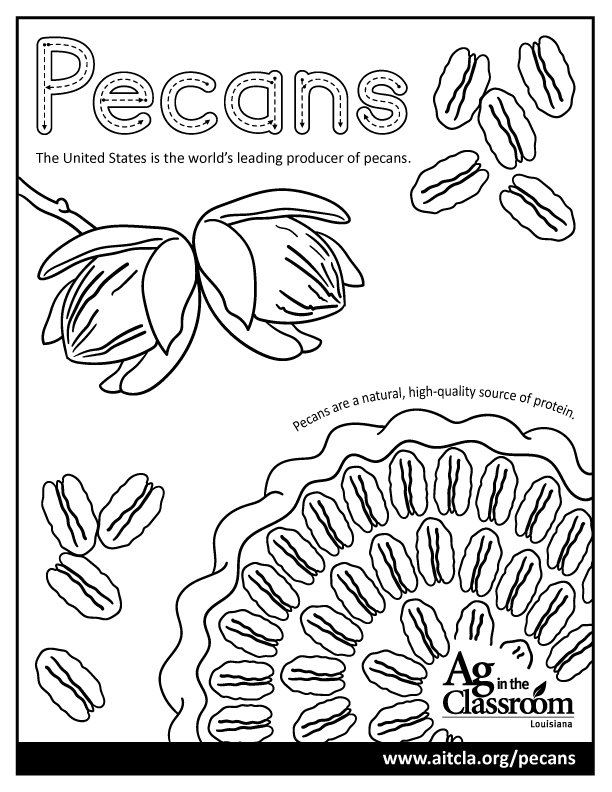HISTORY
The pecan is the only major tree nut that is native to North America. They can be traced back to the 16th century originating in central and eastern North America.
The term pecan comes from the Algonquin Native American word paccan or pakan meaning a nut so hard it had to be cracked with a stone. They became popular due to their ease of peeling, accessibility and great taste.
Thomas Jefferson is credited with their initial popularity in the South. He even presented them to George Washington, who grew them at Mount Vernon. The first Centennial variety of pecans was grafted in Louisiana in 1846 by Antoine, a slave gardener at Louisiana’s Oak Alley Plantation. By the middle of the 19th century, pecans were exploited commercially.
The United States now produces about 80% of the world’s pecans.
PRODUCTION
Pecan trees can grow to over 100-feet tall and can live to be more than 1,000 years old. Because of their size, they need to be planted with 35-ft. spacing between trees and eventually thinned to 50-ft. between the trees. Pecan trees thrive in full sunlight and in soil that is very fertile and deep. They are deeply rooted and require lots of water, especially during growing season.
Pecan tree cultivators in the southern region are not as concerned with pollination as cultivators in other regions because pecan trees are wind pollinated. A pecan tree 10 miles away can be pollinated if wind currents are favorable to transfer the pollen from one tree to the other. Pecan trees are native to the southern region and have adapted to this region over time.
Pecan harvest occurs from mid October to November and even into December. For large scale organizations, mechanical tree shakers are used for harvest. The tree shakers are attached to the base of the tree and shake the tree causing the pecans to fall. Pecans lose their quality quickly after hitting the ground so it is essential to gather pecans very soon after shaking. Fresh pecans need to be air-dried two to three weeks before storing. They are stored in cool, dry protected locations. If they are stored for more than a month, they are sometimes frozen.
Pecans are grown in 15 U.S. states. Louisiana harvests an average of 6.5 million pounds of pecans each year.
PRODUCTS
Pecans are produced as fresh nuts, as well as processed products. Pecans can be sold as whole nuts, halves, pieces, granules or meal for use in many desserts and other food products.
Pecan trees come in a variety of sizes: mammoth, extra large, medium, small and midget. The wood from pecan trees is used to create wood products.
NUTRITION
Pecans are a good source of protein and unsaturated fats. They contain a significant amount of essential amino acids. They also contain more than 19 vitamins and minerals including: vitamin A, folic acid, magnesium, vitamin E, calcium, phosphorus, potassium, zinc, iron, vitamin B, vitamin C, thiamine and niacin. They contain compounds with antioxidant properties that help fight the buildup of LDL cholesterol, also known as “the bad cholesterol”. Pecans are also heart healthy and sodium free.
RECIPE
Pecan Pie
Ingredients:
1 cup sugar
½ cup firmly packed light brown sugar
¼ cup all-purpose flour
2 eggs
2 tablespoons corn syrup
1 teaspoon vanilla extract
½ cup melted margarine or butter
1 cup finely chopped pecans
9-inch unbaked pie shell
Directions:
Preheat oven to 350 degrees.
In large mixing bowl, combine all ingredients, except pecans, mixing well. (If mixture is lumpy, use electric mixer to combine all ingredients well.)
Stir in pecans.
Pour mixture into unbaked 9-inch pie shell.
Bake at 350 degrees for 45-50 minutes or until done.
Foods à la Louisiane—a cookbook by the Louisiana Farm Bureau Women
Submitted by Betty Jo Brian of East Baton Rouge Parish
COLORING PAGE
Select the image below to download, print and color this fact sheet. Fit-to-page printing option recommended. See more commodity coloring pages!
LESSON PLANS
Grades 3-5
Cracking Open the Story of Nuts
In a Nutshell


